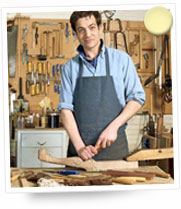 How expensive is it – relatively speaking – to have something made by Pacifica Custom Woodwork?
How expensive is it – relatively speaking – to have something made by Pacifica Custom Woodwork?
We pride ourselves on producing high-end work for much less than a high-end shop would charge. But we won’t kid you; we cost more than Home Depot, Lowe’s, or other “big box” stores that pass their contracts to third parties. We can’t compete with them – and we don’t want to. What one gets there is “semicustom” cabinets – mostly mass-produced parts selected and organized to fit the floor plan you select. Our work is completely custom, and the materials we use are superior to those commonly used to build mass-produced cabinets.
How are your materials different?
Ah, now THIS is one of the conversations we love to have! Even if you are not considering us for your custom work, we hope you’ll pay attention here; it’s useful information for you to consider – especially when you are buying cabinets.
* First, a new term: Basic cabinet boxes and shelves are made from panel stock, like plywood. All panel stock is not created equal, and the differences can be very important to you. Cheaply produced cabinets are commonly made from MDF (medium density fiberboard) or particle board because they cost less than plywood. Plywood is a much better material for cabinetmaking. It is less likely to be damaged by a glancing blow, and is MUCH more resistant to sagging under a load. For instance, a 24-inch wide shelf made from MDF will sag significantly under a load of only 18 lbs (particleboard is somewhat stronger but comparable), while a 24-inch plywood shelf won’t begin to sag until the load approaches 64 lbs! So don’t let a fast talker tell you that it doesn’t matter what panel stock is used to build your cabinets. (see Building Bookshelves to Last, Jeff Miller, Fine Woodworking vol. 190, pp 38-43)
* Second, there’s the veneer that makes panel stock look nice. A thin plastic film over panel stock is cheaper than a real hardwood veneer, and it saves on staining and finishing costs, so film veneers are commonly seen on inexpensive cabinets. The film looks nice enough initially, but there are a few problems. One is that moisture frequently gets under the film, and then is trapped there – causing the MDF or particle board to swell. Another is that the plastic veneer is often seen adjacent to real wood or plastic “wood”, and they don’t react the same way to light. Over time, the parts that were color-matched will no longer agree. Real wood – whether veneer or solid – will react similarly to light, and color discrepancies over time will be minimal.
What if I don’t have a design? I have sort of an idea of what I want, but I’m not very good at picturing it.
This is one of our specialties. We will sit with you and go over the possibilities until we have a concrete image of what you want. We’ll take that input, make a drawing and present it to you. Once you actually see your ideas on paper, you might want them tweaked a bit. No problem; the initial drawing and the first modification are free. Or – you might have seen something in a magazine or catalogue that is close to what you want, but not quite there. We can work from that as well. We haven’t lost a client yet; the process is part of the fun!
 How expensive is it – relatively speaking – to have something made by Pacifica Custom Woodwork?
How expensive is it – relatively speaking – to have something made by Pacifica Custom Woodwork?